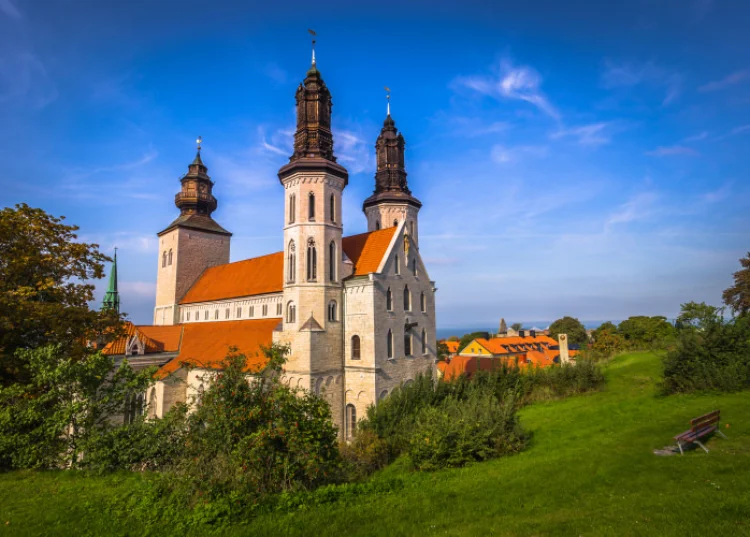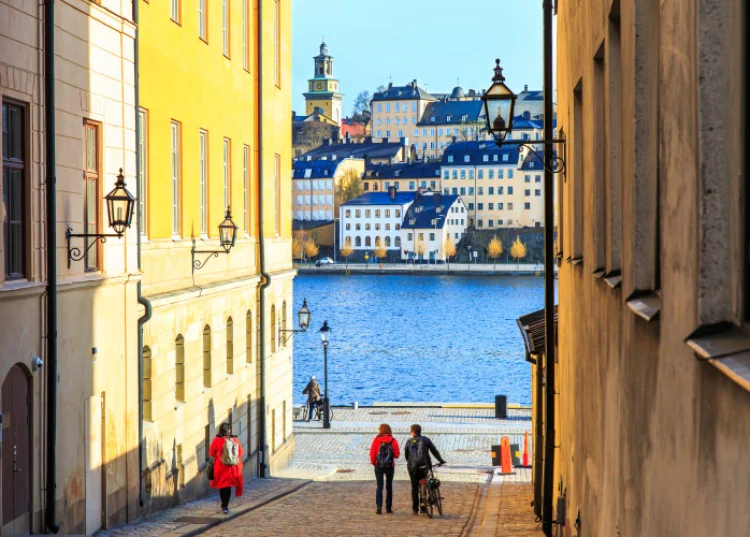The largest country in Northern Europe, Sweden has been inhabited by Germanic peoples since prehistoric times. Sweden’s Norse population – also known as the Vikings – sailed and plundered their way across both the Baltic and the North Seas.
The Vikings were followed by the spread of Christianity and in the 16th century the Protestant Reformation reached Sweden. At this point Sweden was also part of the Hanseatic League – a wealthy trading organisation formed in Lübeck, Germany. Merchants swarmed into Stockholm, making Sweden’s capital rich.
From this long history, the historical sites Sweden has to offer include Kalmar Castle, Drottningholm Palace and the fascinating Vasa Museum, built around an almost entirely preserved medieval ship.
To help you get started we’ve put together a guide showcasing the 10 best historical sites of Swedish cultural locations and monuments.

1. Drottningholm Palace
Drottningholm Palace is a well-preserved royal palace in Sweden, renowned as the ‘Versailles of Scandinavia’.
The first incarnation of Drottningholm Palace was built by King Johan III in the late 16th century. The king built it for his wife, Queen Katarina Jagellonika, hence its name meaning ‘Queen’s Island’. However, this palace was razed to the ground by a fire in 1661 and a new one built in its place in 1662, marking the foundation of the Drottningholm Palace visible today.
It was the influence of Crown Princess Louisa-Ulrika in the 18th century which can still be felt most keenly. She had Drottningholm Palace renovated in image of Versailles, taking inspiration from the opulence of Louis XV.

2. Kalmar Castle
Kalmar Castle or ‘Kalmar Slott’ is a medieval castle whose history dates back to the 12th century. Originally only made up of a lone fortified tower, Kalmar Castle developed over time to become an imposing stronghold and castle.
A defence tower was built on the site where Kalmar Castle now stands around 1180. The tower’s purpose was to protect the area from attacks by pirates and other enemies.
Kalmar Castle played an important role in Swedish history and was the site at which the Union of Kalmar was signed in 1397. Queen Margareta was the mastermind behind the union which unified Sweden, Norway and Denmark through a common monarch and common foreign policy. The union also worked as a counterweight to the German Hanseatic League.

3. Vasa Museum
The Vasa Museum (Vasamuseet) in Stockholm, Sweden, offers a fascinating and detailed insight into the 17th century Vasa ship, which sank on its maiden voyage but was recovered in the 20th century to become the only surviving ship of its era.
The Vasa was intended to be a masterpiece of naval engineering with 64 guns and capacity to fit 300 soldiers.
On 10 August 1628, the Vasa took its maiden voyage before crowds of spectators and with over 150 passengers. However, minutes into the journey, it began to sway violently before it finally tipped over and tragically sank.

4. Visby
Visby in Gotland, Sweden, is a unique example of a northern European medieval walled trading town with a well-preserved townscape and collection of historic buildings. As a Hanseatic Town (a part of the Hanseatic League), Visby has historically been a thriving trading port and town with a powerful trade alliance originating in Lubeck, Germany.
Visby’s prominence as a trading and political centre came to an end in 1525, when it was stormed by an army from Lubeck and the northern parts were burnt. In the 18th century, Visby revived, and many warehouses were refurbished and houses and new buildings were created.

5. Gamla Stan
Gamla Stan, literally Old Town, is the historical quarter of Sweden’s capital city, Stockholm. Dating back to the 13th century, Gamla Stan was originally called ‘själva staden’ which means ‘the city itself’ and is mostly located on the island of Stadsholmen.
From the mid-19th century to the early-20th century, Gamla Stan was considered a slum with many of its historic buildings in disrepair. In fact, after World War Two several blocks were demolished to make space for the Riksdag parliamentary building. Yet from the 1970s the area became popular for its medieval and Renaissance architecture and remains a charming tourist district.

6. Riddarholm Church
Riddarholm Church is one of Stockholm’s oldest buildings, with parts of this imposing historic structure having been built in 1270 and completed in around 1300.
The church originally belonged to a medieval greyfriars monastery, but following the Reformation in the 16th century, it was transformed into a Lutheran church and the monastery was closed.
While you’re wandering around, look out for the coats of arms of the Royal Order of the Seraphim on the walls of the church – they’re erected when a knight dies and the day the funeral takes place the bells ring at Riddarholm non-stop for one hour.

7. Gamla Uppsala
Gamla Uppsala, also called Uppsala Högar, is a famous ancient burial site in Sweden that includes hundreds of ancient graves, most notably the three large burials known as The Royal Mounds.
With its roots stretching far back in time, much of the history of Gamla Uppsala is unclear and mingles into the semi-mythical legends of the earliest kings of Sweden. What is known is that the area was of great religious and political importance during the Iron Age and Viking Age. The three Royal Mounds themselves likely date from the 6th century AD.

8. Borgholm Castle
Borgholm Castle, also known as Borgholms Slott, is a ruined medieval castle and palace complex located on the Swedish island of Öland. It is now a popular tourist attraction and one of the most picturesque castles in the country.
The origins of the original fortifications built on this site are obscure, but it is believed that a castle has stood at Borgholm since around the 12th century AD.
Over the following centuries, Borgholm Castle was often involved in the conflicts which often took place between the Nordic kingdoms and was damaged and rebuilt several times – including a significant rebuild under Gustav I of Sweden and his son John III.

9. Tanum Rock Carvings
The UNESCO-listed Tanum Rock Carvings are a collection of Bronze Age carvings found in the area around the modern town of Tanumshede in Sweden.
With at least 350 distinct groups of rock art comprising of hundreds of individual carvings, Tanum Rock Carvings are one of the most fascinating collections of its type in Europe.
The carvings date from around 1700 BC and 500 BC and depict scenes from the lives of those who lived in the area during this period, including scenes of ships, hunting and domestic life. During the Scandinavian Bronze and Iron Ages, people were good craftsmen with the ability to travel extensively by water. Many of the carvings show boats carrying around a dozen passengers, while also depicting carts or wagons.

10. Vitlycke Museum
The Vitlycke Museum near Tanumshede in Sweden explores the history of the Bronze Age culture of the region and serves as a great starting point for those seeking to explore the Tanum Rock Carvings – a collection of hundreds of Bronze Age rock carvings found in the area.
The museum also includes a recreation of a Bronze Age farm with a number of exhibits exploring domestic life of the period. The farm has reconstructions of two Viking longhouses, one from the Old and one from the New Bronze Age.

